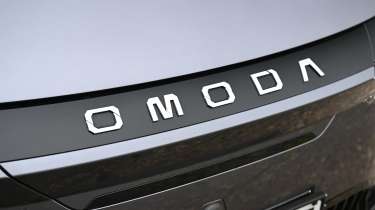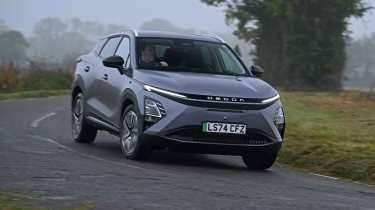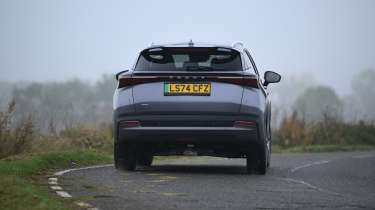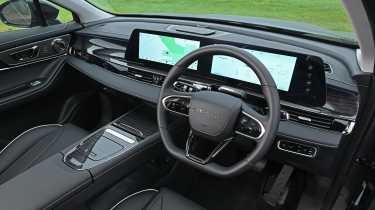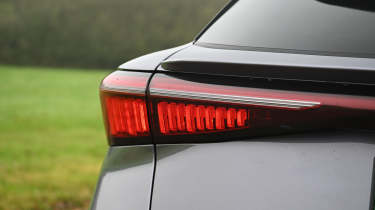Omoda E5 review
Omoda’s debut on the UK’s EV market is a pretty promising one
Pros
- Feels pricier than it actually is
- Pretty good to drive
- Pleasing performance
Cons
- Not the most refined powertrain
- Limited charging speed
- Irritating infotainment
| Range | Wallbox charge time | Rapid charge time |
| 257 miles | 8.25hrs (0-100%, 7.4kW) | 28min (30-80%, 80kW) |
There’s a steady flow of newcomers arriving on the UK’s shores as the nation takes its steps towards fully-electric motoring, and Omoda is one of the names that’s hoping to take a slice of this potentially lucrative market. The Omoda E5 is a fully-electric SUV and this, alongside the combustion-powered Omoda 5, is the first of the brand’s cars to hit our roads.
Take one look at the E5 and it isn’t too difficult to figure out which established models that it’s attempting to lure customers away from. Electric SUVs like the Renault Scenic, Hyundai Kona Electric, MG ZS EV and Honda e:Ny1 are all in the firing line, as are petrol-powered models like the Nissan Qashqai, Kia Sportage and Skoda Karoq.
The competition is fierce, then, but the Omoda E5 certainly seems in with a shout of becoming a decent seller. Inside, the cabin is a pleasant place to be thanks to a smattering of fabric and metallic surfaces combined with twin 12.25-inch curved displays, while underneath the 61.6kWh battery returns a reasonable WLTP combined range of 257 miles.
There’s a reasonable amount of shove on offer from the E5’s single front-mounted motor, too, with 183bhp and 340Nm of torque on tap. While it’s no performance car, this family-friendly EV will accelerate from 0-62mph in a steady 7.2 seconds, and this should be more than enough for a hurried school run.
If you’re clued up on electric SUVs, you might notice one thing about all these figures, and that is that they are better described as adequate rather than class-leading. Among such a large pool of rivals, the E5 is a tad generic to look at on the outside, too, although it is at least easy on the eye. With a starting price that’s just north of £33,000, the Omoda’s debut EV certainly isn’t the cheapest SUV on the market, either, but the brand is offering some attractive PCP deals to counteract this issue.
In terms of on-board kit, things are straightforward, with only two trim levels to choose from; Comfort and Noble. The entry-level Comfort model comes pretty well-equipped, too, with LED headlights, 18-inch alloy wheels, wireless Android Auto and Apple CarPlay, wireless device charging and a reversing camera.
For around £1,500 more, upgrading to Noble trim adds in electronically adjustable front seats, a powered tailgate, sunroof, a 360-degree parking camera and an eight-speaker Sony stereo system.
Range, battery size & charging
| Model | Range | Wallbox charge time | Rapid charge time |
| E5 | 257 miles | 8.25hrs (0-100%, 7.4kW) | 28min (30-80%, 80kW) |
There’s only one battery to be found at the heart of the Omoda E5, and that is a 61.1kWh unit which officially returns up to 257 on the WLTP combined cycle, regardless of trim level.
While this figure is reasonable by todays’ standards, it falls a bit short of the similarly priced MG ZS EV Long Range models, which can cover up to 273 miles. The E5’s real-world efficiency does come pretty close to the brand’s claims, though, as we achieved an average of 3.8 miles per kWh during testing, which equates to a total range of around 230 miles.
When it’s time to plug in, a full charge at a typical household rate of 25p per kWh will set you back by around £15, which is very reasonable compared to filling up a petrol or diesel SUV of the same size.
If you need a quick top-up at a public rapid charging station, this will almost certainly cost more than charging at home. You might be waiting for a bit longer than you’d like, too, as the Omoda E5’s DC charging capacity can only reach speeds of up to 80kW. Again, this falls short of the MG ZS EV, as this offers speeds of up to 94kW.
Running costs & insurance
Pricing for the Omoda E5 starts from £33,055 for the entry-level Comfort model, and moving up to Noble trim will add on another £1,500 to the price. This makes the Omoda cheaper than the Renault Scenic which starts from £37,495, while the Honda e:Ny1 sits at over £40,000. However, the MG ZS EV is still a relative bargain as it can be bought brand-new from £30,495.
Omoda isn’t fully relying on the cash price to tempt customers into E5s, though, as the brand is already PCP deals with low deposits and even zero interest. If you’re considering an Omoda, a bit of negotiation could work wonders.
When it comes to running this electric SUV, there’s the usual emissions-based charging exemption, and VED road tax remains at zero until April 2025. Company car drivers can make the most of the coveted 2% Benefit-in-Kind tax rate, too.
As we mentioned earlier, a full charge at home could cost less than £20, depending on your energy tariff. Insurance is unlikely to be notably cheap, but premiums shouldn’t be too alarming, either, with the E5 Comfort sitting in group 34 while the range-topping Noble resides in group 35.
Performance, motor & drive
| Model | 0-62mph | Top speed | Driven Wheels | Power |
| E5 | 7.2 seconds | 107mph | Front | 183bhp |
Realistically speaking, few family SUV buyers are pushing their cars to the limit on a regular basis, but having a bit of extra oomph to get ahead of traffic can certainly come in useful.
The Omoda E5’s sole front-mounted motor produces a respectable 183bhp and 340Nm of torque, so it can get a pretty decent move on when required. 0-62mph is dealt with in 7.2 seconds, and the E5 will then continue on to a top speed of 107mph. However, the front wheels appeared to struggle with all this torque during testing, especially in wet weather.
When it’s not being pushed, the Omoda strikes a pleasant balance between comfort, handling and refinement. However, once again, none of these areas can be described as class leading.
There are two steering modes to choose from, and this allows for lighter operation when driving in town. You can then add a bit more weight for higher speeds. Maintaining a steady cruising speed did prove a little bit challenging during testing, though, as the motor regeneration was a bit too eager to kick in when lifting off the throttle.
Interior, dashboard & infotainment
Visually, the Omoda E5’s cabin is a pretty upmarket affair considering its price tag. The metallic switchgear and fabric surfaces do a good job of making things feel a bit posh, however the synthetic leather that adorns the seats does feel cheaper than it looks.
The overall interior layout is modern and fuss-free, and at the centre of the dashboard reside two 12.25-inch curved displays. Both of these are pleasant to look at, and we found them quick to respond during testing.
However, for those who want to use the standard-fit wireless Android Auto or Apple CarPlay, the Brand’s native software will close down entirely when these are in use, so you’ll need to exit the system in order to adjust settings like the temperature or fan speed – a real irritation.
Boot space, seating & practicality
| Length | Width | Height | Boot space |
| 4,424mm | 1,830mm | 1,588mm | 380 litres |
Practicality is the make-or-break factor for many of those who are searching for a family SUV, and the Omoda E5 does feel slightly smaller inside than one particular kingpin of the mid-size SUV world, the Nissan Qashqai.
Taller passengers may soon get a bit fidgety if they’re forced to sit in the back seats, too, as the E5’s high floor means there’s limited thigh support from the seats.
At the very back sits a 380-litre boot, which is also far smaller than the Qashqai’s 504 litres. However, the Omoda does come with a proper space-saver spare wheel as standard, which is a bit of a rarity on today’s market.
Reliability & safety rating
The petrol-powered Omoda 5 was first tested by Euro NCAP in 2022, and it was awarded a full five-star safety rating, however the UK-spec Omoda E5 is yet to be tested.
It’s difficult to determine just how reliable the Omoda E5 is at this early stage, but considering that EVs have fewer moving parts than combustion cars, this should help towards minimising any mechanical issues.
The brand clearly has some faith in its cars, though, as it’s offering a seven-year/100,000 miles warranty as standard on every model. This matches Kia’s standard plan, which set the standard for several years. Only Toyota offers a longer warranty than this at a maximum of ten-years/100,000 miles, but you have to get your car serviced at one of its approved workshops, which could prove costly.


